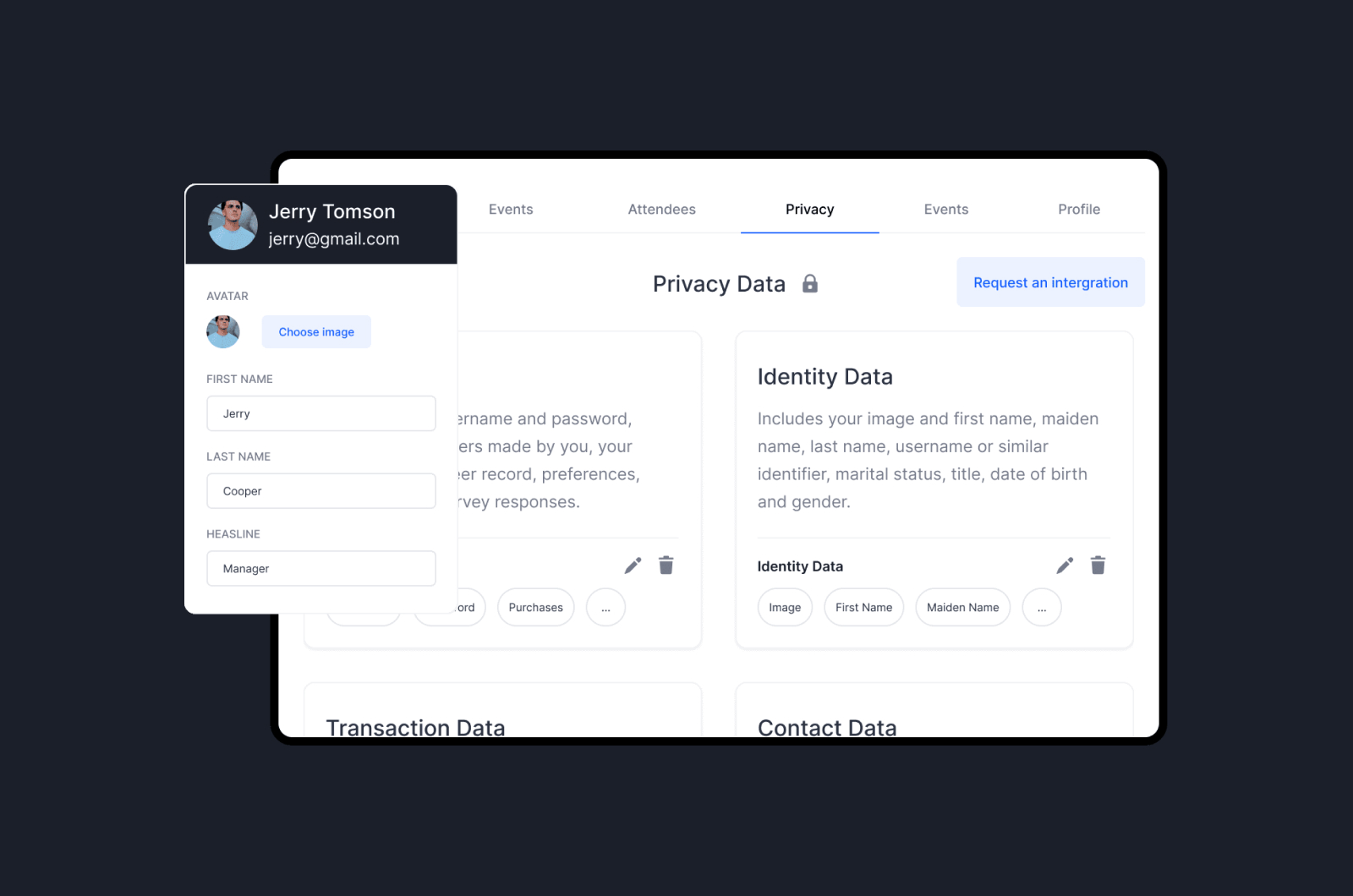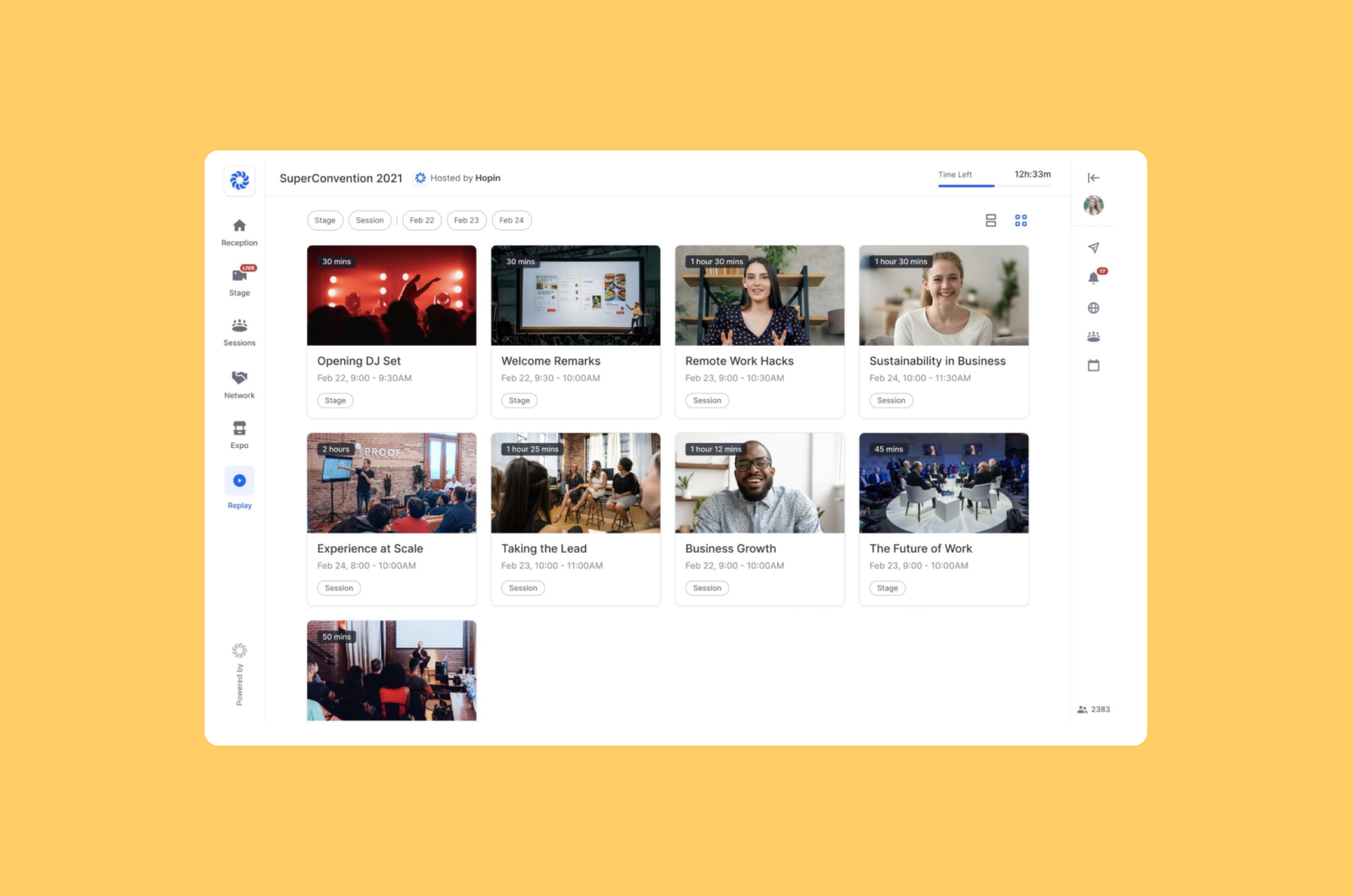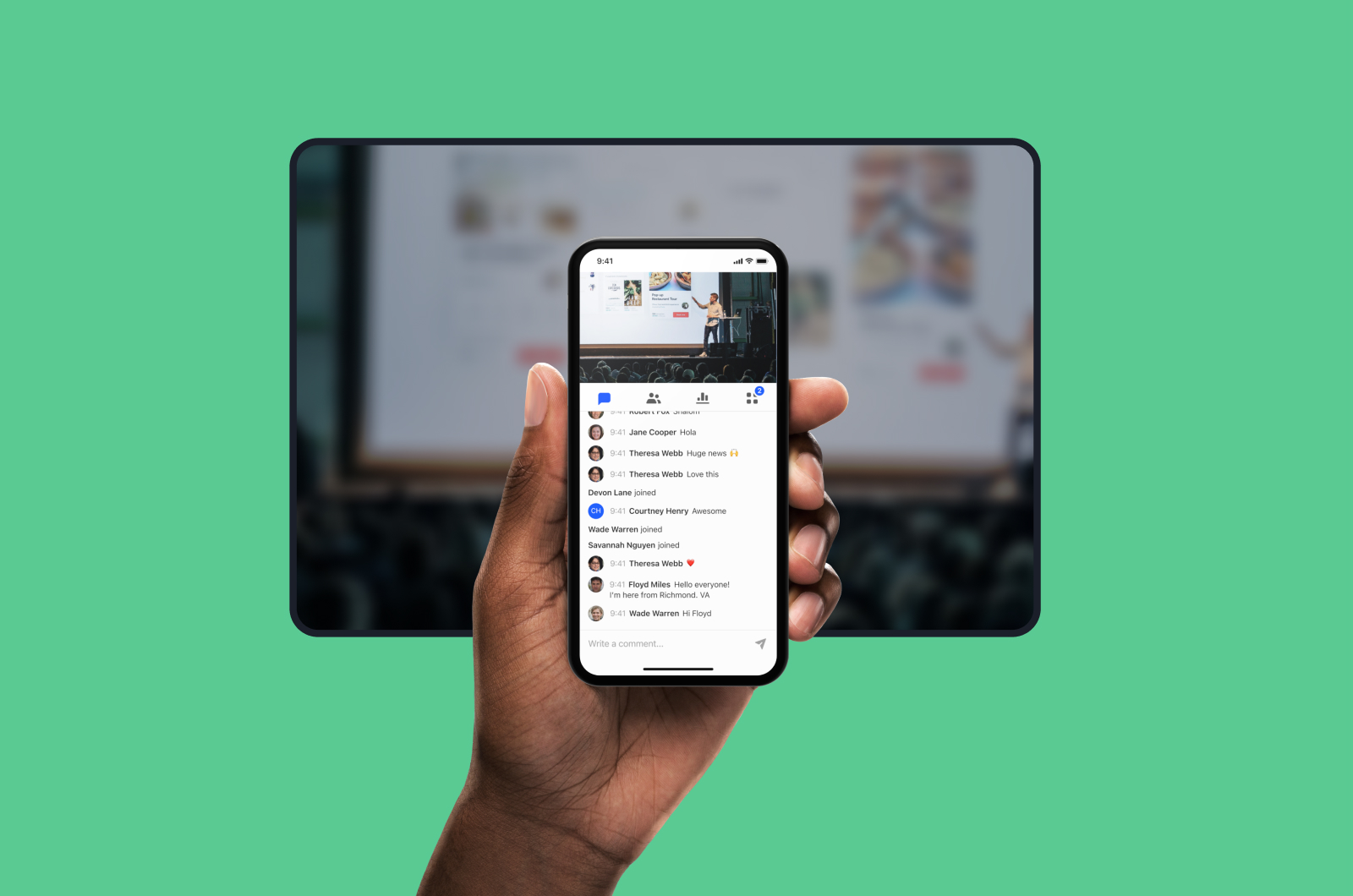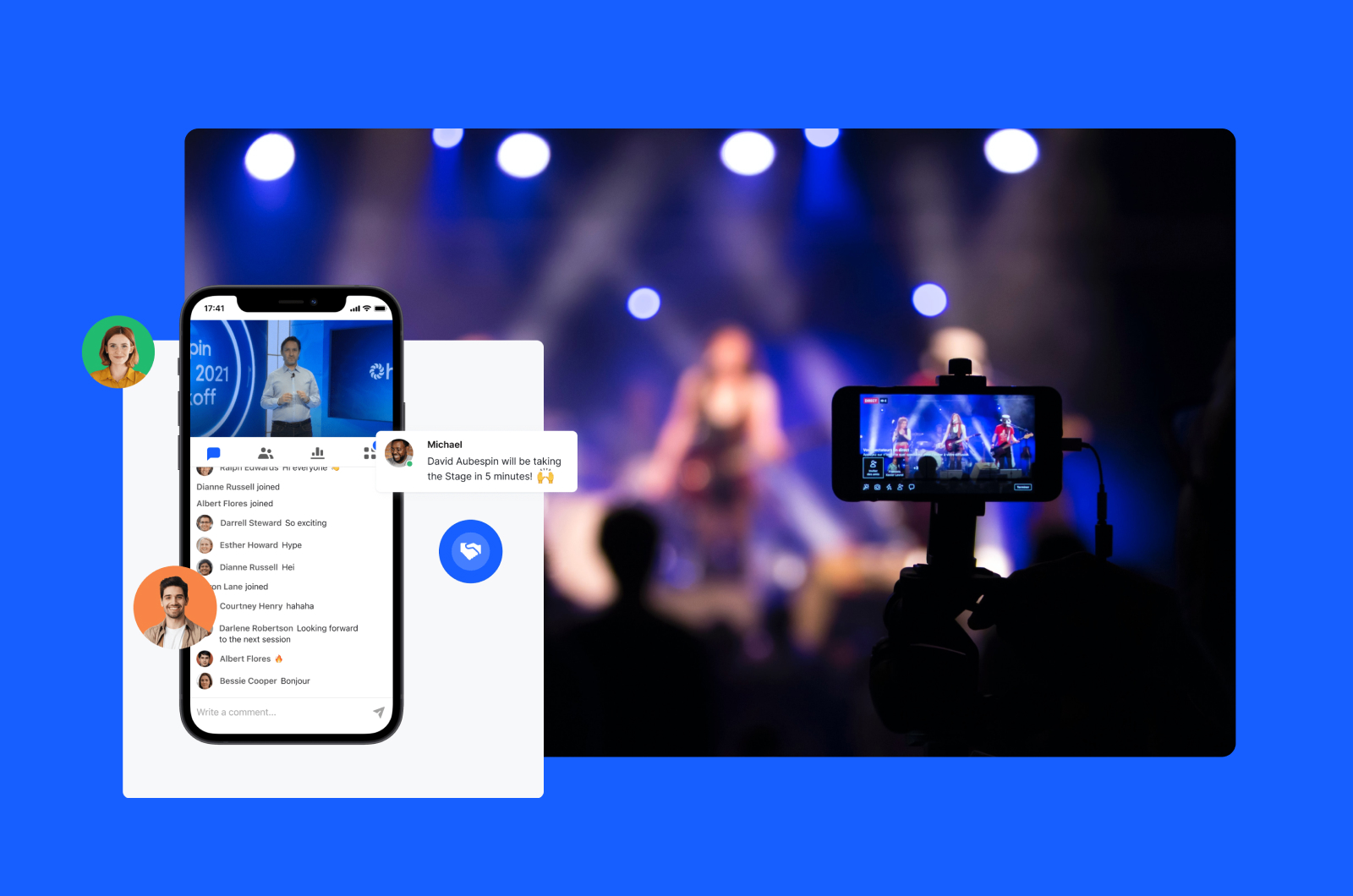Before the pandemic, virtual and hybrid events were less common –– especially as the high-production, immersive experiences they’ve now come to be. They were largely designed to attract future in-person attendees while adding an element of innovation.
The steady development of these formats –– and the technology to support them –– has now accelerated. Their benefits have also come into focus: wider reach, more inclusivity, and increased sustainability –– just to name a few.
But the sudden need for these digital formats had many event professionals scrambling to upskill and pivot to virtual event production. This situation, coupled with industry uncertainty, often felt like starting from scratch.
But as industry professionals have started to adjust and broaden their tech skills, they’ve also been exploring human interaction and dynamics across digital event platforms. How does an online format affect an attendee’s ability to connect and engage in a meaningful way?
To guarantee event success, let’s go back to basics. Connecting with others and sharing experiences is possibly the most important part of events. With so much technological advancement around virtual and hybrid events, planners can sometimes forget that the main goal of an event has and always will be bringing people together.
By using neuroscience to understand how the brain works, planners can gain some valuable insight on how to enhance attendee engagement and interaction to create events that have real and lasting impact.
Keeping the focus on people
In order to plan truly impactful events it’s important to understand how people think and why they behave in certain ways. This is where principles of neuroscience can help.
The brain is our fundamental social tool controlling thoughts, memories, learning capabilities, emotions, sensory processing, motor skills, and every other process that regulates the body. While the use of technology may differ, both in-person and online attendees ultimately need to use their brains to engage and learn at an event.
How we behave and process information as human beings is, according to neuroscience, defined by how our brain responds to perceived rewards and stress on a conscious or nonconscious level.
To fully engage attendees, planners must consider both processes: conscious (thoughts, sensations, memories, and feelings that we are actively aware of) and nonconscious (anything that is not explicitly part of the conscious experience). These processes are foundational in understanding our ability to engage in social settings. However, nonconscious triggers can be quite different in an online environment compared to in-person.
By incorporating event engagement tips and tools based on neuroscience, and customizing technology to suit these needs, we can shape the attendee experience and ultimately improve event outcomes.
Using neuroscience to create more memorable experiences
A simple way to use neuroscience in event design is to incorporate the SCARF model, created by Dr. David Rock in 2008. The model singles out five domains of human social experience:
1. Status: Where an individual stands in comparison to others
2. Certainty: Minimization of threats by predicting the future
3. Autonomy: A sense of control over life and events
4. Relatedness: Community belonging and acceptance (friend or foe)
5. Fairness: Perception of fair and unbiased exchange between people
Dr. Rock’s research is still considered the gold standard in understanding how people engage in social situations. The model suggests that the more people feel understood, connected, and safe, the more likely they are to respond positively.
This sense of security and belonging also decreases cortisol (the stress hormone), making it easier for people to fully engage and learn from their environment and event content. The aim is to minimize the mental overload of too many tension factors such as irrelevant information, not knowing how to use the technology, or managing multiple sessions.
While understanding how people behave is vital to creating successful events, acquiring the practical know-how to implement this understanding requires real-life examples — especially when faced with new event formats.
How to get started
To start, planners should create an event engagement strategy that includes the overall event objectives, target audience, format (hybrid, virtual, or in-person), and how these goals relate to the technology involved.
Choosing a technology partner that is people-centric and connection-focused is vital when aiming to maximize attendee engagement and belonging.
Hopin, for example, recently launched their new mission to make the world feel closer. In a post on Hopin’s blog, Johnny Boufarhat, the company’s CEO and founder, said: “Closeness is about our ability to engage, to be part of something, to belong. Our lives are shaped by the world around us — the people we come in contact with, the opportunities we have access to, the experiences we can take part in.”
With the human behavior insights provided by the SCARF model, we can be thoughtful about how we use on-site and online event technology to connect people.
Here are 15 tips on how to improve attendee engagement –– all grounded in neuroscience.
15 attendee engagement tips based on neuroscience
STATUS: WHERE AN INDIVIDUAL STANDS IN COMPARISON TO OTHERS
Status relates to how we see ourselves and others in social situations. It includes our personal and professional identity, values, and an overall sense of connection with the people we’re closest to. Here are a few ways planners can account for this need:
Ticketing options and access to platform-specific areas
Let your attendees know about all the features and content available to them in a way that helps elevate their profile among peers. Different ticketing options and digital experiences designed specifically for either in-person or virtual attendees can help drive a sense of elevated status.
Custom content
Highly valuable, custom content is vital to any event. Whether it’s an in-demand speaker session or breaking news, creating one-of-a-kind event content that has never been seen before will make your attendees feel like they’re getting the star treatment. Another strategy is to create tailored attendee experiences by customizing session visibility based on professional subgroups.
Connect to a cause
Social impact and responsibility are a significant part of brands’ commitment to communities. Create a strong emotional connection and empower people to give back by supporting a charitable cause or topic at your event. Hopin recently announced their new integration with GoFundMe. The integration allows event organizers to set up the ability to raise funds right inside the event platform, giving attendees the opportunity to learn about an initiative, make a donation, and monitor total contributions in real time.
CERTAINTY: MINIMIZATION OF STRESS BY PREDICTING THE FUTURE
Certainty relates to how confident people feel in regards to future social situations. At an event level, planners can interpret this as attendees knowing what to expect at an event.
Is your event organized? Do attendees have access to sessions and schedules? Do they know what time certain activities start and end? These examples relate to attendee certainty and knowing what comes next:
24/7 access
Incorporating event information that’s available 24/7 on your event website, platform, or app is a sure-fire way to make attendees feel secure in knowing what comes next. Notifications and alerts are another great way to ensure attendees stay informed.
Catch-up clips
Make on-demand sessions available to your audience after the live event has ended. Knowing they can revisit the content later will help attendees extract value from multiple sessions and avoid a fear of missing out.
Event safety and security
While event safety has always been important, now more than ever attendees want to know organizers will do everything they can to put attendee safety first. Attendees also need assurance that when they sign up for an event, their security and privacy has been considered.


AUTONOMY: A SENSE OF CONTROL OVER LIFE AND EVENTS
People generally don’t like to feel they’re not in control of their life choices. With so much uncertainty at play, autonomy is more relevant than ever.
How can planners structure an event to meet objectives while giving attendees the freedom to participate in the activities that hold the most value for them?
It’s also important to take comfort levels into account. Planners should give attendees control over certain aspects of an event, but guard against too many variables to avoid overwhelming attendees. For example, scheduling decisions like meal times should follow a predictable structure.
Here are a few ways to support attendee autonomy at an event:
Include customizable agenda functionality
Allowing attendees to have control of their schedules can cater to their interests and help them manage their time. Adding topic tags to sessions can also make it easier for attendees to identify their top session choices.


Networking
Creating authentic networking opportunities for virtual and hybrid events can be challenging. But when you use tools that offer a combination of open and targeted networking, it brings a sense of fun into connecting online and empowers attendees to build the network they want to create.
Seek out flexible event management plans
As an event organizer, you want the ability to build the events you want from scratch in a matter of minutes — whether it’s a conference, team building event, workshop, or a mixture of event types. Look for flexible planning options that will allow you to bring your event strategy to life.
RELATEDNESS: COMMUNITY BELONGING AND ACCEPTANCE (FRIEND OR FOE)
Relatedness refers to our sense of belonging and acceptance –– it’s the foundation for connection. The more attendees feel connected to something bigger than themselves at an event, the more likely they’ll engage.
Know your audience
Use integrations to get to know your event audience through pre-event surveys and interactive sessions. The better you know the people you’re building an experience for, the better content you can create for them.
Focus on the purpose
Now that you know more about your target market, you can structure the purpose, look, feel, and sound of your event according to their needs, giving attendees a feeling of belonging and acceptance. Storytelling is a great way to communicate company values and event purpose.
Be human
Events are about people. Before objectives and analytics, planners need to be human and put attendees’ needs and wants first.


FAIRNESS: PERCEPTION OF FAIR AND UNBIASED EXCHANGE BETWEEN PEOPLE
We respond to social situations by measuring how reasonable the group decisions that affect us have been. Fairness also relates to justice and what we feel are appropriate measures.
How are you creating fair rules of engagement at your event? Does your event cater to a wide variety of people or only a select few, and on what basis?
Inclusion
Create inclusive content and make it accessible to all by leveraging product integrations that support functionality like translations, closed captioning, and sign language.
Diversity
Ensure that people from around the globe attending your event are represented and have a voice on your event platform. Diversity in speakers introduces a wider variety of topics and points of view, adding value to your event.
Equal event benefits
Don’t leave attendees hanging. Create an event that caters to both in-person and online audiences.
BONUS: ENGAGE THE SENSES
Designing around brain function is not just about following the SCARF model, but also about considering how we interact with our immediate environment through our five senses. Event design and production should stimulate the senses from visual, auditory, smell, taste, and touch perspectives.
While the latter three senses may be trickier to engage online, it’s not impossible. For example, planners can send out sensory boxes before the event and include sessions that relate to wellness and movement to stimulate feel-good hormones and emotions.


Crafting thoughtful, engaging experiences
Research suggests that social interaction and connection with others are critical to our survival as a species –– as much as food or shelter. Events are social activities that bring groups of people together, regardless of format.
Event professionals need a foundational understanding of what makes people think, respond, and act in various ways in order to design truly engaging experiences that bring people together.
We should create experiences that take attendees on an immersive journey of learning, inspiration, and connection. With tools like the SCARF model and the help of tech partners with relevant expertise, planners can produce events that allow attendees to extract genuine value from every experience.






